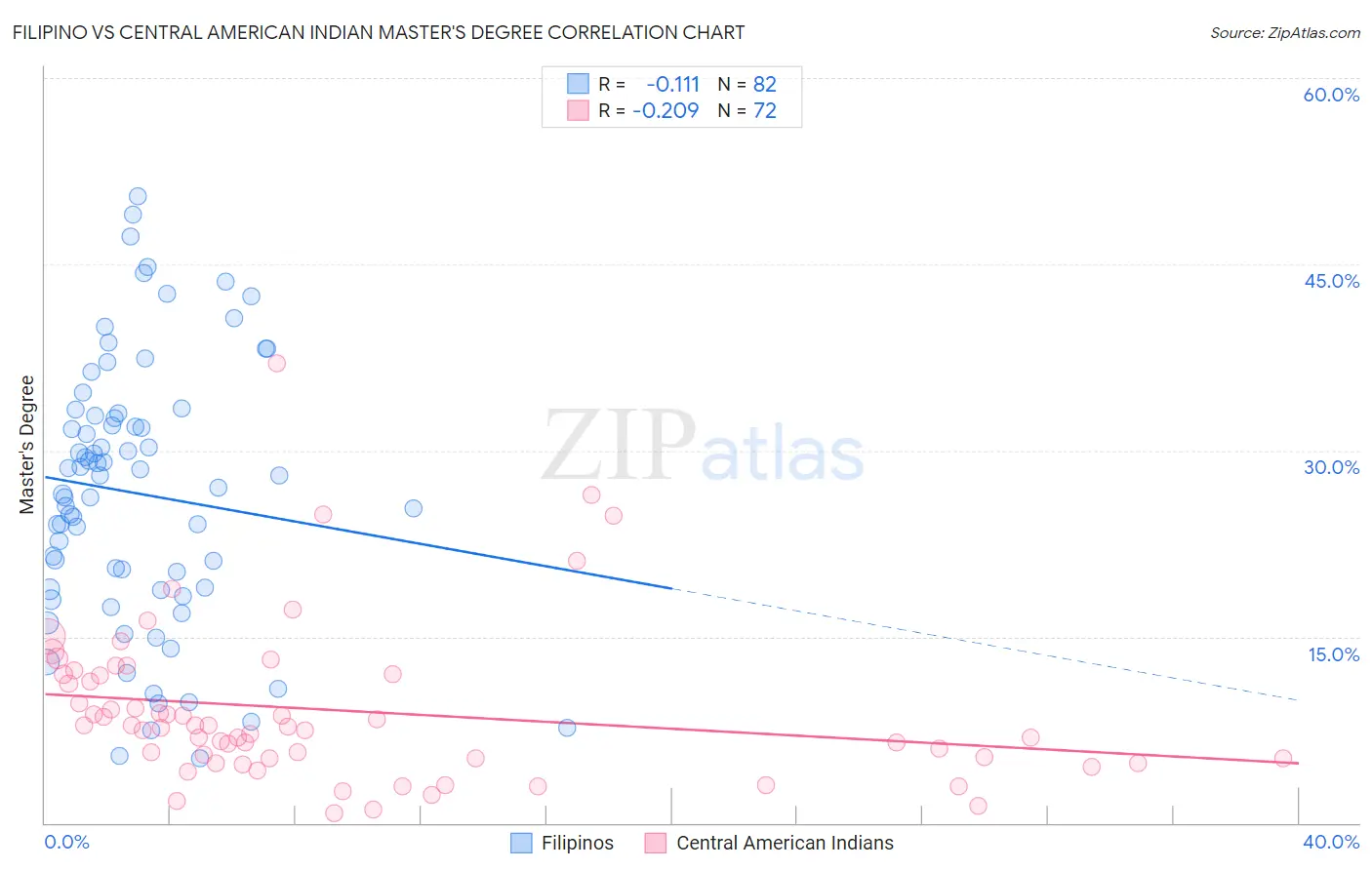Filipino vs Central American Indian Master's Degree
COMPARE
Filipino
Central American Indian
Master's Degree
Master's Degree Comparison
Filipinos
Central American Indians
23.4%
MASTER'S DEGREE
100.0/ 100
METRIC RATING
2nd/ 347
METRIC RANK
12.4%
MASTER'S DEGREE
0.5/ 100
METRIC RATING
263rd/ 347
METRIC RANK
Filipino vs Central American Indian Master's Degree Correlation Chart
The statistical analysis conducted on geographies consisting of 254,302,816 people shows a poor negative correlation between the proportion of Filipinos and percentage of population with at least master's degree education in the United States with a correlation coefficient (R) of -0.111 and weighted average of 23.4%. Similarly, the statistical analysis conducted on geographies consisting of 326,067,650 people shows a weak negative correlation between the proportion of Central American Indians and percentage of population with at least master's degree education in the United States with a correlation coefficient (R) of -0.209 and weighted average of 12.4%, a difference of 88.2%.

Master's Degree Correlation Summary
| Measurement | Filipino | Central American Indian |
| Minimum | 5.2% | 0.78% |
| Maximum | 50.5% | 37.0% |
| Range | 45.2% | 36.3% |
| Mean | 26.5% | 9.1% |
| Median | 27.5% | 7.7% |
| Interquartile 25% (IQ1) | 18.8% | 5.2% |
| Interquartile 75% (IQ3) | 32.8% | 11.9% |
| Interquartile Range (IQR) | 14.0% | 6.7% |
| Standard Deviation (Sample) | 10.7% | 6.4% |
| Standard Deviation (Population) | 10.6% | 6.4% |
Similar Demographics by Master's Degree
Demographics Similar to Filipinos by Master's Degree
In terms of master's degree, the demographic groups most similar to Filipinos are Immigrants from Singapore (23.4%, a difference of 0.050%), Immigrants from Israel (22.6%, a difference of 3.4%), Okinawan (22.6%, a difference of 3.4%), Immigrants from Taiwan (22.5%, a difference of 4.2%), and Immigrants from India (22.3%, a difference of 4.9%).
| Demographics | Rating | Rank | Master's Degree |
| Immigrants | Singapore | 100.0 /100 | #1 | Exceptional 23.4% |
| Filipinos | 100.0 /100 | #2 | Exceptional 23.4% |
| Immigrants | Israel | 100.0 /100 | #3 | Exceptional 22.6% |
| Okinawans | 100.0 /100 | #4 | Exceptional 22.6% |
| Immigrants | Taiwan | 100.0 /100 | #5 | Exceptional 22.5% |
| Immigrants | India | 100.0 /100 | #6 | Exceptional 22.3% |
| Iranians | 100.0 /100 | #7 | Exceptional 22.3% |
| Cypriots | 100.0 /100 | #8 | Exceptional 21.8% |
| Thais | 100.0 /100 | #9 | Exceptional 21.7% |
| Immigrants | Iran | 100.0 /100 | #10 | Exceptional 21.6% |
| Immigrants | China | 100.0 /100 | #11 | Exceptional 21.2% |
| Eastern Europeans | 100.0 /100 | #12 | Exceptional 21.1% |
| Immigrants | Australia | 100.0 /100 | #13 | Exceptional 20.9% |
| Immigrants | Switzerland | 100.0 /100 | #14 | Exceptional 20.9% |
| Immigrants | Eastern Asia | 100.0 /100 | #15 | Exceptional 20.8% |
Demographics Similar to Central American Indians by Master's Degree
In terms of master's degree, the demographic groups most similar to Central American Indians are Belizean (12.4%, a difference of 0.17%), Immigrants from Fiji (12.4%, a difference of 0.19%), Nicaraguan (12.5%, a difference of 0.23%), Bahamian (12.4%, a difference of 0.34%), and Tongan (12.5%, a difference of 0.42%).
| Demographics | Rating | Rank | Master's Degree |
| Immigrants | Portugal | 0.8 /100 | #256 | Tragic 12.6% |
| Osage | 0.7 /100 | #257 | Tragic 12.6% |
| Immigrants | Liberia | 0.6 /100 | #258 | Tragic 12.5% |
| Japanese | 0.6 /100 | #259 | Tragic 12.5% |
| Dominicans | 0.6 /100 | #260 | Tragic 12.5% |
| Tongans | 0.6 /100 | #261 | Tragic 12.5% |
| Nicaraguans | 0.6 /100 | #262 | Tragic 12.5% |
| Central American Indians | 0.5 /100 | #263 | Tragic 12.4% |
| Belizeans | 0.5 /100 | #264 | Tragic 12.4% |
| Immigrants | Fiji | 0.5 /100 | #265 | Tragic 12.4% |
| Bahamians | 0.5 /100 | #266 | Tragic 12.4% |
| Americans | 0.4 /100 | #267 | Tragic 12.3% |
| Native Hawaiians | 0.4 /100 | #268 | Tragic 12.3% |
| Central Americans | 0.3 /100 | #269 | Tragic 12.2% |
| Salvadorans | 0.3 /100 | #270 | Tragic 12.2% |